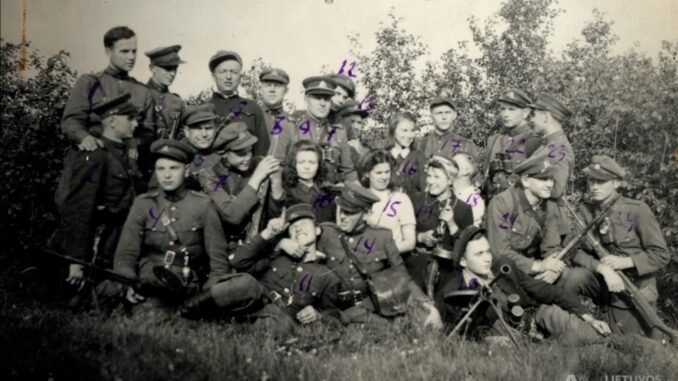
Women in the Lithuanian Partisan War plaid a crucial role. “I recognize only a free, independent, autonomous Lithuania, without the custody of any other State. For me, partisans are not bandits, but great warriors for their idea, for their noble purpose, for the freedom of their Homeland.” Vanda Pazukaitė, Panevėžys Girls High School teacher, a partisan liaison in Algimantas County, in the December 29, 1947, statement of her testimony to the investigator.
When the second Soviet occupation began in 1944, a partisan war lasting 10 years was set in motion, seeking to restore Lithuania’s independence, writes Vilma Ektytė, Head of the KGB Documents Division of the Lithuanian Special Archives .
The experience of the first Soviet occupation, repression, and terror, forced mobilization into the Red Army, patriotism and love for the Homeland, the belief in Western aid, led to thousands of people becoming participants in the armed resistance to Soviet occupation.
Most of the partisans were men, but women were also actively involved in the struggle for freedom, who, by cherishing a love for their relatives and believing in the freedom of Lithuania, contributed to the struggle for freedom – belonged to the armed resistance units, gave an oath, had weapons, and lived illegally.
The majority of the women in the Lithuanian Partisan War were females whose men, brothers or fiancées were partisans and whose relations with the partisans were revealed during the time of the Soviet State Security.
Women occupied important positions in military structures
Seeking to avoid arrest and deportation, they took to hiding in the bunkers in the huts in the forest or the sponsor’s homesteads. Women occupied important positions in the partisan military structures: they took care of the press, they were responsible for collecting intelligence, managing economic affairs, finances, and were involved in the liquidation of spies, Soviet-party activists, and other combat operations.
Many female partisans were killed during military-check operations conducted by Soviet Security. Some of them, not wanting to surrender when Security discovered their hiding places, were blown up or shot. Some of the women who joined the partisan squad did not participate in the armed struggle; they prepared meals, washed and provided clothing, and worked as medical nurses.
To protect the women partisans from persecution by the Soviet Security, the partisan leadership helped them acquire fictitious documents so that they could live legally. Many girls and women were partisan assistants: liaison and supporters.
Liaisons maintained contacts between partisan leadership, districts, units, and individual teams, organized meetings and contact points, transmitted knowledge and documents, distributed the press, and searched for people who could provide intelligence.
Partisan supporters set up shelters for partisans on their farms, provided information on the appearance of the secret police and troops of the “stribai” (translator’s note: Russian collaborators), provided partisans with food, clothing, medication, other items, and distributed partisan press.
Informants and agents everywhere
One of the main methods of the Soviet security structures’ war with the partisan movement was the recruitment of agents and informants among residents, partisans, their associates, and sponsors. Some of the paths of betrayal were chosen by free will; the promises of the occupying power tempted others; some persons were broken down by threats and blackmail. Many freedom fighters and their supporters were killed or arrested because of betrayals.
Punishment for betrayal and the regulations for enforcement are found in the partisan documents from the very beginning of the armed resistance. After the partisans established a unified senior leadership in 1949 – the Lithuanian Freedom Fighters Movement – who started leading the political and military struggle for the liberation of the nation, the LLKS Criminal Code was adopted.
The death penalty was allowed for espionage and for providing knowledge to the authorities of the occupation agencies, for having executed violent measures on behalf of the occupation government, government officials of the occupation government, denunciations, etc. Convictions by the Partisan Military Field Courts were also enforced for women who had betrayed freedom fighters to the occupation.
Thousands killed by the Soviets
In 1944-1953, Soviet repressive structures killed more than 20 thousand partisans, arrested about 19 thousand partisans and about 12 thousand of their assistants. Women in the Lithuanian Partisan War suffered the same hardships and atrocities of partisan warfare: arrests, torture, prison camps, exile, and death.
Although the freedom fighters did not reach their most important strategic goal – they did not restore an independent democratic state of Lithuania, the significance of the resistance struggle is huge. In 1940, the freedom fighters proved that Lithuania was joined to the USSR against the will of the nation, and it left aspirations for the freedom of the nation for future generations.
In 1990, after the restoration of the independence of Lithuania, the 1944-1953 partisan war was recognized as one of the historically significant foundations of the restored State. The women in the history of the partisan war left impressive examples of courage, endurance, and sacrifice, featuring heroism and feats in defending Lithuania’s freedom and independence. After evaluating their merits, many women partisans were awarded Lithuanian State Awards – Orders of the Cross of Vytis, Medals of Volunteers of the Lithuanian Armed Forces, and others.

Be the first to comment